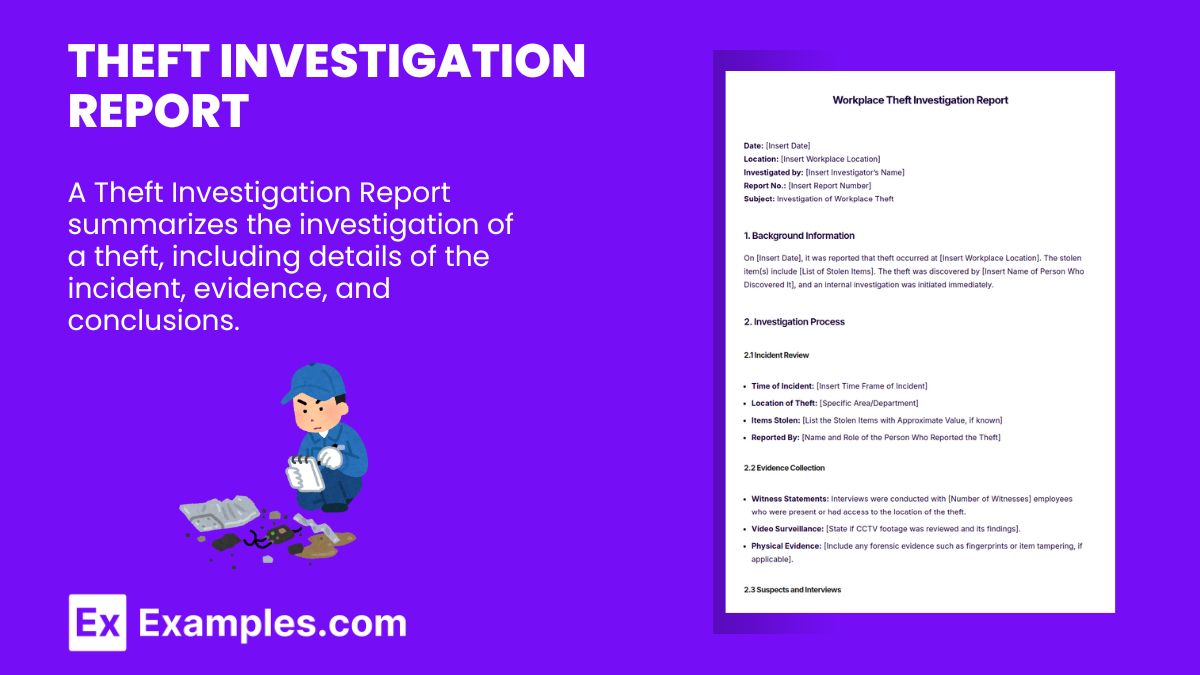13+ Theft Investigation Report Examples
Have you ever witnessed or experienced being robbed? It could be in any shape or form. Property, your identity, or anything you placed in your computer. Hoping that you do not have to go through this kind of situation, but one can never be too careful. When it happens to you, imagine having to go through a lot of paperwork due to what others may assume as petty theft. But from your side of the room, it was more than just petty theft.
It was an invasion of your privacy, it was an invasion of someone else stealing from under your nose. It was someone or an organized crime against you. How do you think you would handle that kind of situation? Of course you would feel threatened, hurt and you would want to find a way to eliminate this kind of problem. By doing so, you must begin writing a theft investigation report. The sooner the better as they always say. Check out the article to let you know how you can write a theft investigation report.
What is Theft Investigation Report?
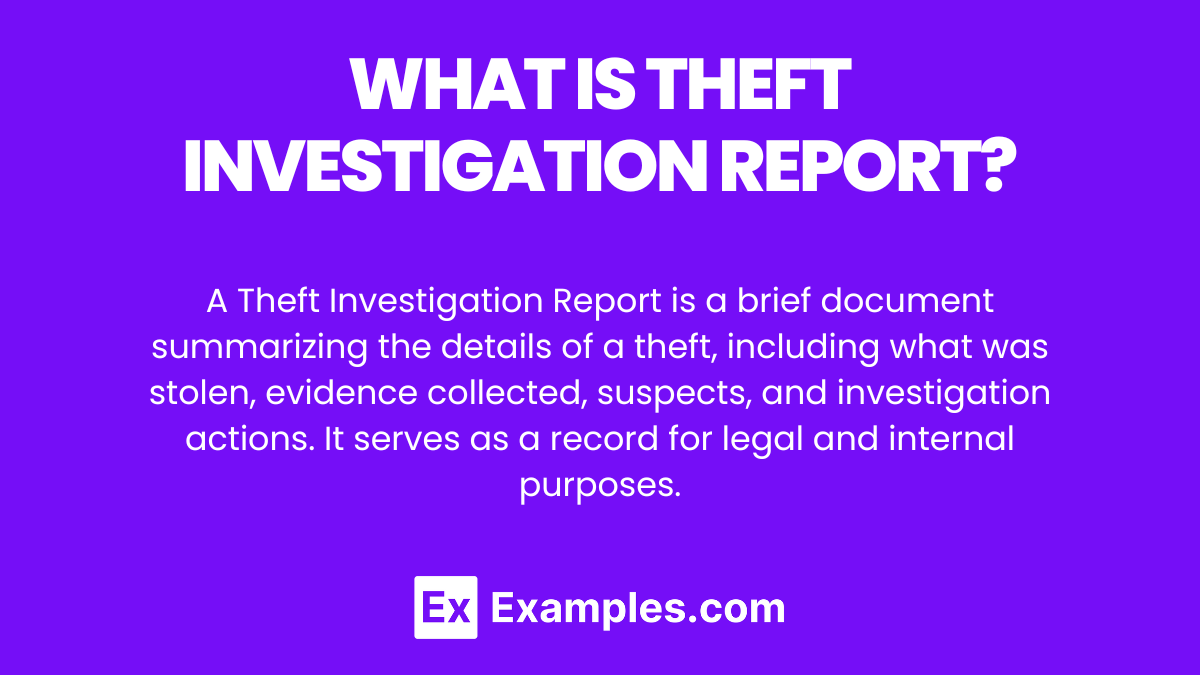
Theft Investigation Report Bundle
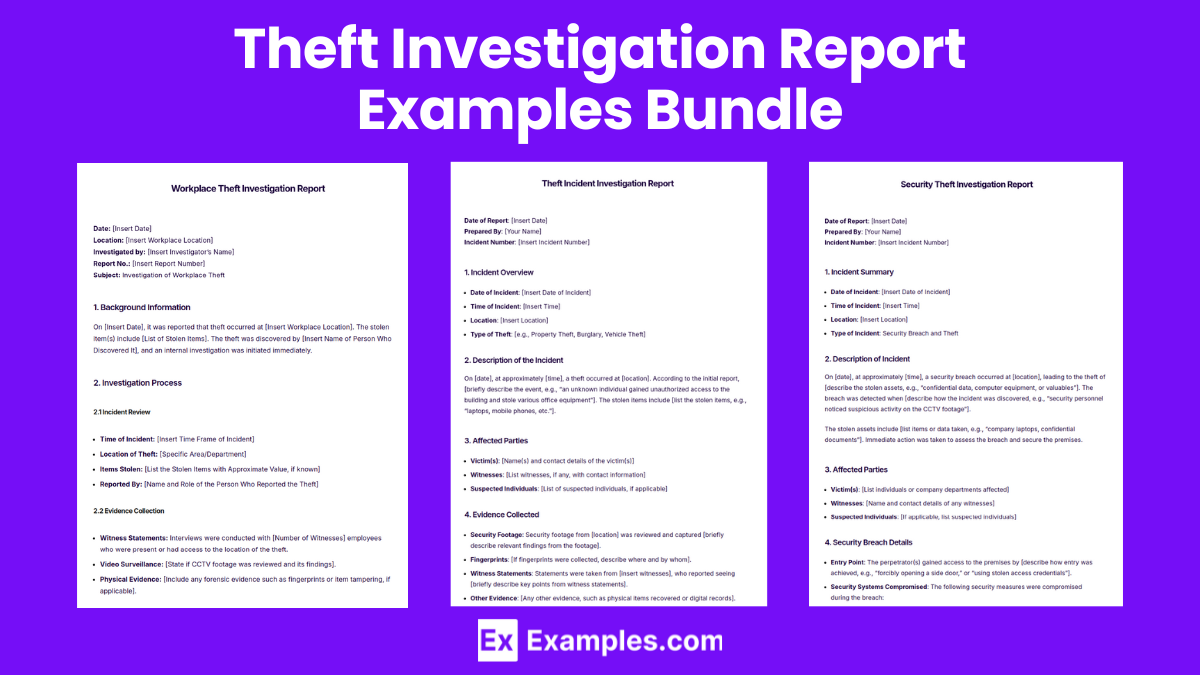
Download Theft Investigation Report Bundle
Theft Investigation Report Format
Opening Remarks
Greeting: Begin with a formal and respectful greeting.
Introduction
Purpose: Briefly state the purpose of your report.
Acknowledgments
Investigating Team
Recognition: Thank the main investigators and staff who conducted the investigation.
WitnessesAppreciation: Acknowledge the contributions of witnesses and individuals who provided information.
Security PersonnelGratitude: Show appreciation to the security team who assisted in the investigation.
Forensic ExpertsAcknowledgment: Thank the forensic experts for their role in analyzing the evidence.
Administrative StaffAppreciation: Recognize the efforts of administrative staff who provided assistance during the investigation.
Closing Remarks
Summarize: Briefly recap the key points of the investigation and findings.
Final Thanks: Offer a final word of thanks.
Farewell
Goodbye: End with a polite farewell.
Theft Investigation Report Example
Date of Report: October 22, 2024
Investigating Officer: Officer John Doe
Report Number: 00123-45678
Location: XYZ Corporation, 1234 Main Street, City
IntroductionThis report outlines the investigation into a theft incident that occurred at XYZ Corporation on October 15, 2024. The purpose of this report is to provide a comprehensive account of the investigation process, the evidence collected, and the conclusions drawn from the findings.
Incident SummaryOn October 15, 2024, at approximately 8:00 PM, XYZ Corporation’s security team reported a missing batch of electronic components valued at $50,000 from the storage room. The loss was discovered during a routine inventory check. The items in question were last accounted for during the previous shift change at 4:00 PM. A theft investigation was immediately launched to identify the suspect(s) and recover the stolen property.
Investigation Process
Initial Response
Upon receiving the report, the investigation team arrived at the scene within 30 minutes. The storage room was secured, and the immediate area was inspected for signs of forced entry. No damage to the locks or doors was found, suggesting that the theft was an inside job.Interviews
The team conducted interviews with all employees who had access to the storage room during the day. Five employees, including the shift manager and two warehouse workers, were questioned. Their statements provided insight into the sequence of events leading up to the discovery of the theft.Surveillance Footage
The investigation team reviewed the security camera footage from the time the items were last seen at 4:00 PM until the time they were discovered missing. A suspicious individual, later identified as an employee named Jane Smith, was seen entering the storage room without proper authorization.Forensic Evidence
Fingerprint analysis and forensic examination of the storage room door handle and inventory sheets were conducted. The prints found on the handle matched those of Jane Smith.Suspect Interrogation
Jane Smith was called in for questioning. Initially, she denied any involvement, but after being presented with the video footage and forensic evidence, she admitted to stealing the components. She confessed that she planned to sell them to a third party.
FindingsThe investigation concluded that Jane Smith, an employee with access to the storage area, was responsible for the theft. Her motive appeared to be financial gain, as confirmed by her confession during interrogation. No other employees were involved in the incident.
Recommendations
- Implement stricter access controls for sensitive areas within the company, including keycard entry systems.
- Conduct regular audits of high-value inventory to ensure early detection of discrepancies.
- Provide additional training to security staff on monitoring and responding to suspicious behavior.
Short Theft Investigation Report Example
Date of Report: October 22, 2024
Investigating Officer: Officer John Doe
Report Number: 00123-45678
Location: XYZ Corporation, 1234 Main Street, City
Incident SummaryOn October 15, 2024, a theft of electronic components valued at $50,000 was reported at XYZ Corporation. The items were taken from the storage room during the evening shift. An investigation was launched to identify the suspect and recover the stolen property.
Investigation SummarySecurity footage showed employee Jane Smith entering the storage room without authorization. Forensic analysis matched her fingerprints to those found on the door. After questioning, Jane Smith confessed to the theft. The stolen items were recovered, and she was terminated from her employment.
Workplace Theft Investigation Report
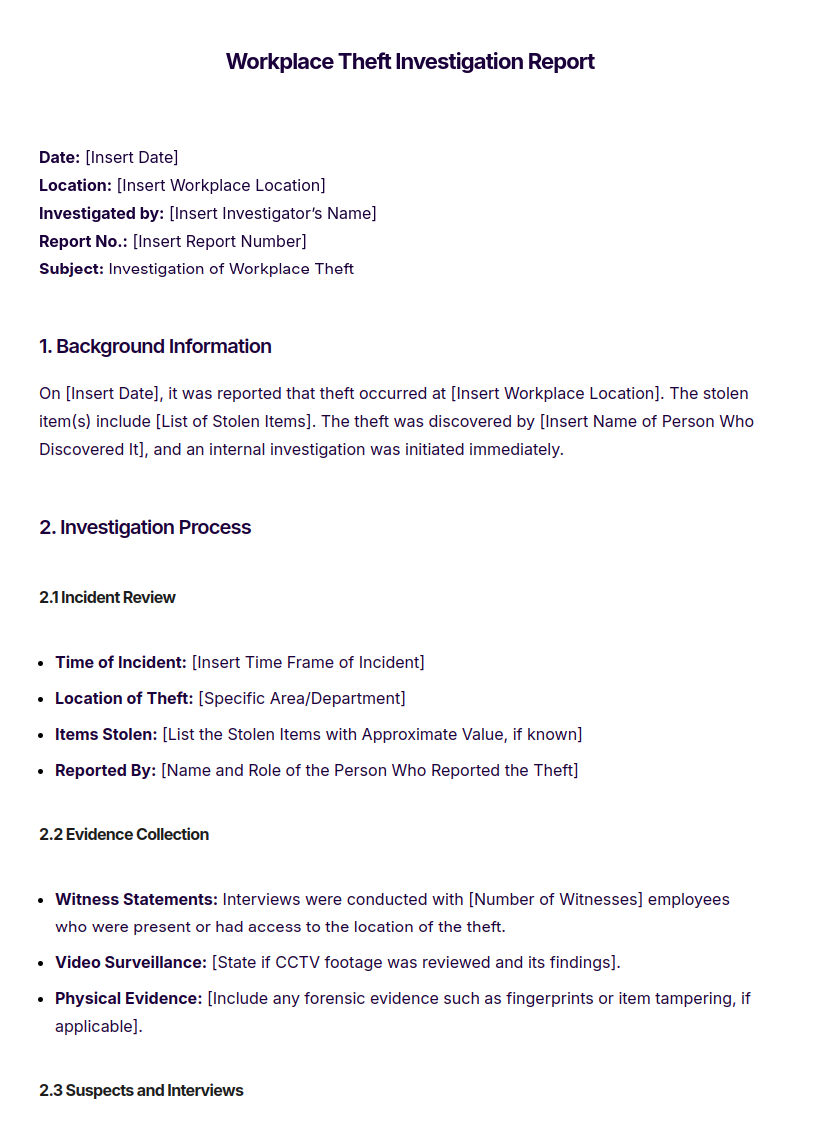
Theft Incident Investigation Report

Security Theft Investigation Report
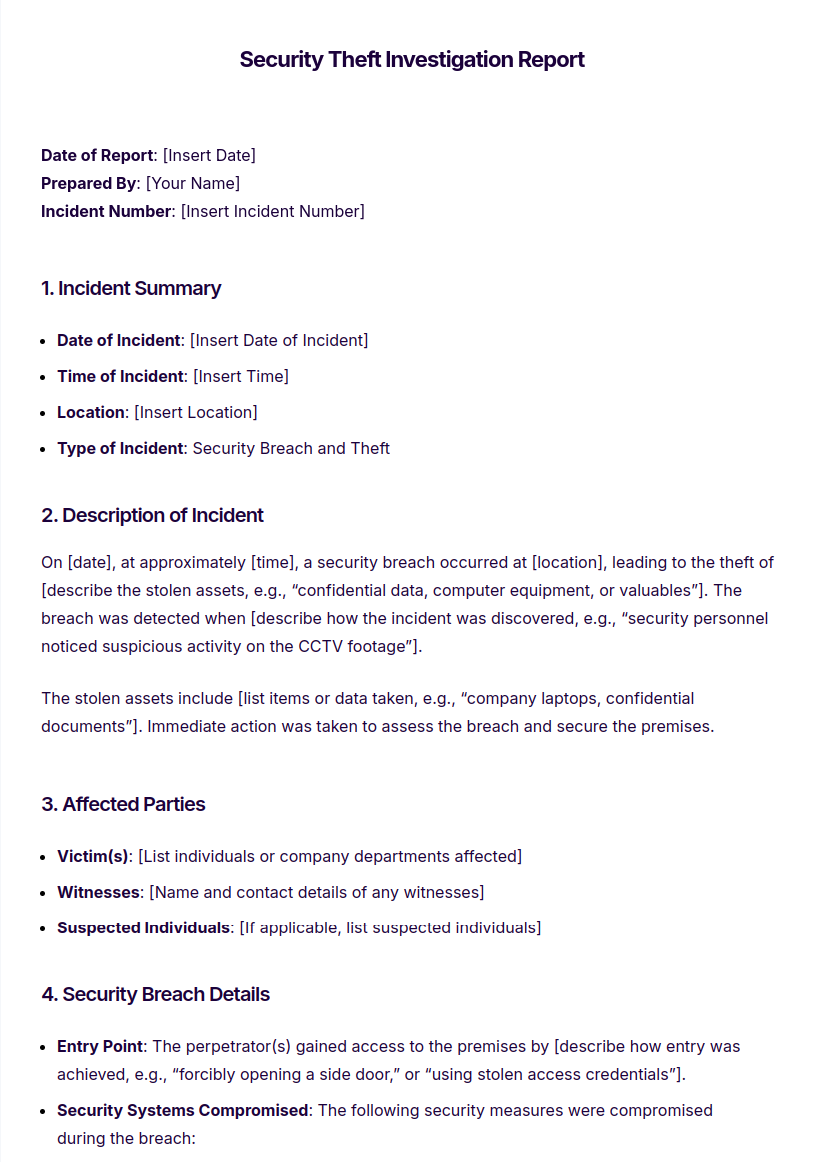
More Theft Investigation Report Examples and Samples
Theft Investigation Report Examples
1. Theft University Investigation Report
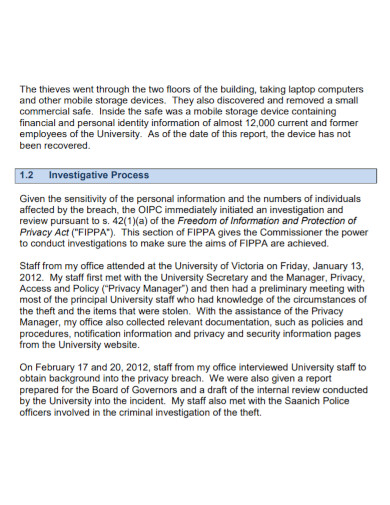
2. Theft Investigation Report Template

3. Standard Theft Investigation Report
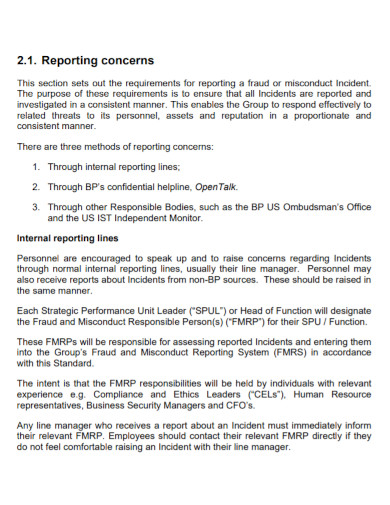
4. Identity Theft Investigation Report

5. Private Theft Investigation Report

6. Computer Theft Investigation Report
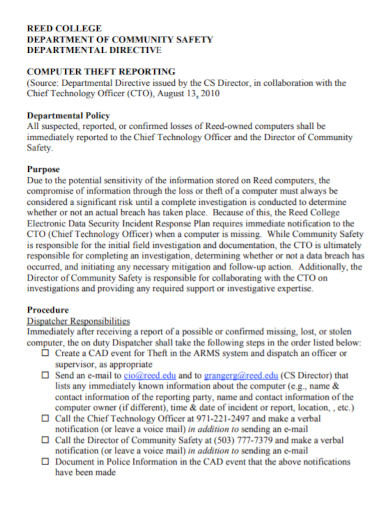
How to Write Theft Investigation Report?
When writing a Theft Investigation Report, it’s important to be clear, concise, and factual, ensuring that all necessary details are documented. Here’s a step-by-step guide to writing one:
Report Heading
Title: Theft Investigation Report
Date: Include the date of the report.
Report Number (if applicable): Assign a unique number for reference.
Prepared by: Name and title of the investigator.Introduction
Incident Date: Specify when the theft occurred.
Location: Mention where the theft took place (e.g., address, business, etc.).
Parties Involved: List all individuals involved (victim, suspects, witnesses, etc.).
Purpose: Briefly explain the purpose of the investigation (e.g., to determine the facts surrounding the theft of certain property).Summary of Incident
Description of Theft: Provide a clear and objective account of what was stolen, how, and when the theft was discovered.
Initial Actions Taken: Include details of any immediate steps taken, such as securing the scene, contacting authorities, or speaking to witnesses.
Evidence Collected: List any evidence that was gathered, such as security footage, witness statements, or forensic evidence.Details of the Investigation
Interviews: Summarize the interviews conducted with witnesses, employees, or suspects. Include any relevant statements that may help with the case.
Evidence Examination: Document the analysis of any evidence, such as stolen goods, security footage, or digital records.
Investigative Findings: Present any findings that support or disprove the allegations of theft. For example, any inconsistencies or corroborated details from witness testimony.Conclusion
Final Findings: Clearly state what the investigation revealed about the theft, including whether a suspect was identified, if the stolen property was recovered, or if further investigation is required.
Next Steps: If applicable, outline the next steps, such as pursuing criminal charges, additional investigation, or returning recovered items.Attachments
Include any relevant documents, such as photos, diagrams, interview transcripts, or evidence logs.
Signature
End the report with your signature, title, and date.
Importance of Theft Investigation Report
The Theft Investigation Report is crucial for several reasons, providing both immediate and long-term value to organizations and law enforcement. Here are the key reasons for its importance:
1. Documentation of Facts
- The report serves as an official record of the theft and the subsequent investigation. It captures all critical information, including evidence, witness statements, and findings, ensuring that no details are overlooked or forgotten.
2. Support for Legal Proceedings
- A well-documented report is often used in legal proceedings to prove that a theft occurred, identify suspects, and support prosecution. It provides a structured, factual basis that helps build a case in court, reducing the risk of misrepresentation or confusion.
3. Recovery of Stolen Property
- A thorough investigation report increases the chances of recovering stolen property. By documenting what was stolen (including descriptions, serial numbers, etc.), it helps law enforcement or insurance agencies track and locate missing items.
4. Insurance Claims
- Many insurance companies require detailed investigation reports to process theft-related claims. The report provides proof of the incident, itemizes losses, and validates that an investigation took place, helping to expedite the claims process.
5. Internal Accountability
- For businesses, theft investigation reports ensure internal accountability. They help managers and executives understand how and why the theft occurred, leading to better decision-making about security and prevention measures.
6. Prevent Future Theft
- A detailed analysis of the theft, including security vulnerabilities or procedural failures, helps organizations identify and correct flaws that allowed the theft to happen. This improves security and reduces the risk of future incidents.
7. Transparency and Trust
- A theft investigation report promotes transparency within an organization. Employees, shareholders, or customers may feel reassured knowing that incidents are investigated thoroughly, demonstrating the organization’s commitment to ethical practices and security.
8. Evidence for Disciplinary Action
- In cases where employees or individuals within the organization are suspected of theft, the report can provide the evidence needed to take disciplinary actions, such as termination or legal action.
9. Aids in Communication
- The report is a comprehensive document that communicates the details of the theft to all relevant parties, such as law enforcement, insurance companies, legal teams, and internal stakeholders. It ensures everyone has access to consistent, accurate information.
10. Record for Future Reference
- The theft investigation report becomes part of the organization’s records, which can be referenced for similar future incidents. It serves as a learning tool, allowing the organization to develop better theft-prevention policies based on past experiences.
Tips for Theft Investigation Report
Here are some concise tips for preparing a Theft Investigation Report:
- Incident Summary: Provide a clear and concise overview of the theft, including the date, time, location, and what was stolen.
- Detailed Timeline: Include a chronological order of events, starting from when the theft was discovered to all relevant actions taken.
- Witness Statements: Gather and summarize statements from any witnesses, noting the details they provide and their relation to the incident.
- Evidence Collection: List and describe the evidence obtained (e.g., video footage, physical items, digital records), ensuring proper documentation and handling.
- Suspects Identified: If applicable, mention any suspects, along with their potential motives, behaviors, and connections to the theft.
- Investigation Methods: Explain the steps taken during the investigation, such as interviews, site visits, forensic analysis, or collaboration with law enforcement.
- Analysis of the Theft: Provide insights into how the theft occurred, vulnerabilities exploited, and the methods used.
- Conclusions and Recommendations: End with findings, including any actions to prevent future thefts, improve security, or follow-up steps with authorities.
FAQs
What is the purpose of a Theft Investigation Report?
The purpose of a theft investigation report is to document the facts surrounding the theft, including the incident details, evidence, interviews, and findings from the investigation. It helps in identifying the perpetrator, recovering stolen items, and may be used in legal proceedings.
What should be avoided in a Theft Investigation Report?
Avoid personal opinions, assumptions, or any unverified information. Stick to the facts and ensure objectivity throughout the report. Avoid blaming individuals without sufficient evidence.
Who should write the Theft Investigation Report?
The report should be written by the investigator or security personnel who conducted the investigation. If multiple investigators were involved, one person should compile all findings into a single, cohesive report.
What happens if multiple thefts occurred in the same incident?
If multiple thefts occurred, list each one separately, specifying the items taken, the circumstances, and any differences in how they were carried out. Ensure that each incident is investigated and reported thoroughly.
When should a Theft Investigation Report be written?
The report should be written as soon as possible after the investigation is complete. Timeliness ensures that the details of the incident and investigation are fresh and accurately recorded.
How long should a Theft Investigation Report be?
The length depends on the complexity of the case. Simple thefts may require only a few pages, while more complex cases involving multiple interviews and evidence may require longer reports. Regardless, the report should be clear and concise, focusing on the facts.


